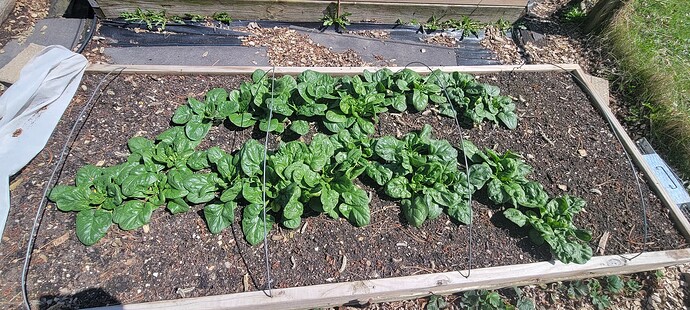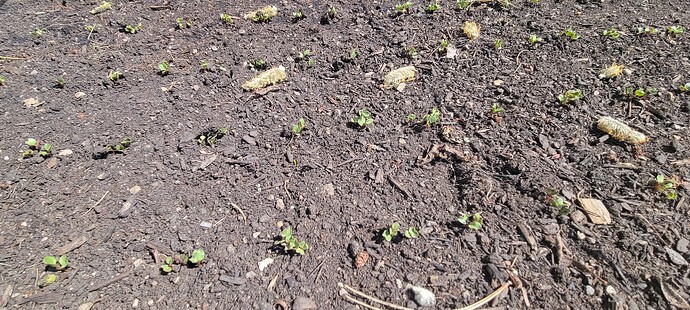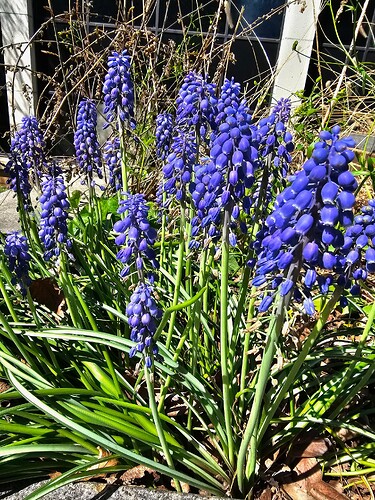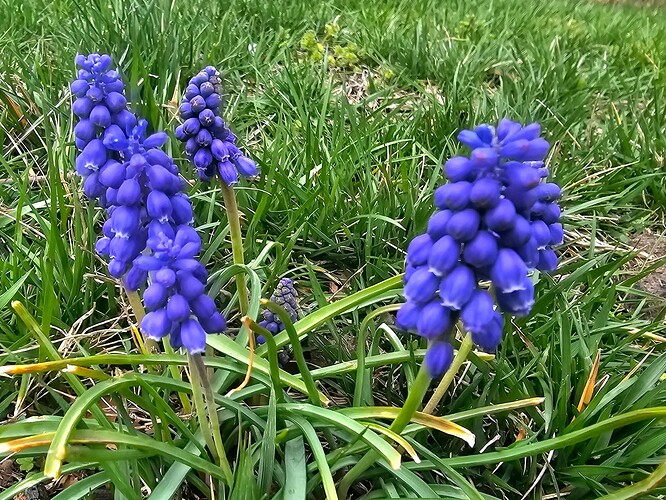Third to @Kii and @Axolotl about containing the mint. Really, put it back in a pot now. You won’t know you have a problem until it’s too late. It’s not quite kudzu or bamboo, but only because it’s smaller.
Okay! I’ll do that soon! Probably not today, as it’s raining, but this week!
Thanks again!

@Axolotl and @kii and @Wayward beat me to it, yet it requires repeating: Put that in a pot! Four years it took to eradicate it from a raised bed, planted by the previous owners of my house. Four years. ![]()
Old timey gardener advice: If you want an easy to grow herb, plant mint. Then stand back so’s you don’t get hurt!
I grow it in large pots and it still escapes! Every year! We make a lot of mint tea, and do use the escapees, but never quite as fast as they run. There is a chunk of my yard that is just mint now. Smells great when I mow, though!
I think I’m going to have to scale back my gardening plans this year. I had plans to expand the garden, but a back injury meant that I ended up cancelling those plans. But now I may have to scale back even more, or maybe hire someone to help out here and there.
Spinach is ready to start picking. It will last until June, or until it gets so hot that it bolts.
Radishes. I direct sowed this year intead of starting indoors. I saved the seeds from last year’s crop. Saved a few bucks on seeds, and I didnt pay for potting soil either. The big fuzzy things are catkins from the willow tree
You may already know about this, but Espoma makes seriously reliable crop insurance in a bag:
One of the best. I’ve used it myself. It has never failed me.
Yup. Good (stinky) stuff. The Meyer lemon with the yellow leaves peeking into that photo has received its first springtime feeding with Epsoma. The Meyer lemons and the calamasi tend to get yellow leaves in January/February after fruiting, but I hold off fertilizing until late March because I don’t want to kick off a growth cycle too soon, in case of a late freeze.
The lemons and thornless key lime are blooming now, and the bumble bees were particularly happy about that this week. I think I should root prune them all soon, since I can’t really handle larger pots than what they are in now, but … eek … they’re blooming and I don’t want to shock them, aside from the logistics and needing help with the heavy lifting.
i have used that on avocados. it is good.
i need to re-up the supply and do the lime tree, as well as the avocado trees.
we’re in a bad way right now for water. rain is waaay behind what it should be and we a currently in what they’re calling “moderate to extreme drought conditions” in south florida and (especially) the keys.
we should have many mango blossoms on our tree. we have one.
this sucks, man!
Plant metabolism slows at colder temperatures and in citrus the leaves can look chlorotic. This is usually when the less experienced citrus fan freaks out.
You are wise.
Nothing more lovely than smelling lemon and lime blossoms. I am… aswoon…
Completely with you on this one.
O for an endless supply of serfs [ /s ] and a heated glazed winter house for my (right now imaginary) herd of citrus trees…
My “orangerie” on the cheap:
A $150 mail order greenhouse, 4 moving blankets, 1 tarp, a radiator-style space heater (not rated for outside use but whatever) on a plastic boot tray, and a borrowed thermostat switch that turned it on and off to keep the temperature range between 28 and 35F
whoa… you serious 'bout your citrus!
good on ya! i just want my avocados, limes and mangoes to do what they 'sposed to do here in the subtropics!
FEED ME!
That makes me think “Eek!”, because I bought a radiator-style space heater for my apartment, and the instructions for mine say to be sure it’s placed on a fireproof surface… I bought a cheap 12x24-inch ceramic floor tile at Home Depot for under $2.
The base where the wheels attached never got past warm to the touch when I used it indoors. I was more concerned about it coming into contact with meltwater or the caster wheels sinking into the paver base gravel than it melting the plastic tray. With the heat set surprisingly low, it was able to maintain the desired temp range.
I used a heavy enough gauge outdoor extension cord, kept the plugs and the heater itself away from water contact, and checked it repeatedly the first two nights. Is it still janky and bodged together? Yup, but it worked.
When we bought this house, one of the big draws was the yard: it has real soil with earthworms and ground bees, not just the biologically dead red clay typical of North Alabama. The previous owner was spent most of her day working in the yard, and I have spent most of my time trying to undo some of her planting decisions. She planted the side yard entirely with day lilies and underplanted them with chameleon vine (aka spawn of Satan). It spreads via underground runner roots/rhizomes, so digging up large areas of it is impractical because if you miss even the smallest piece of root, it will grow back from that. Virginia creeper and poison ivy have invaded as well. I am slowly removing most of the day lilies and spreading mulch in the de-lily-ed areas for now, but I don’t know how to get rid of the chameleon vine without resorting to chemical warfare.
I spot treat with glyphosate (RoundUp) weed killer on young poison ivy and don’t feel bad about that, but spraying most of the side yard with it to try to kill the chameleon vine now while it’s young and tender is problematic for me. Would waiting until later in the summer, when the ground dries out more and the soil life goes deeper, away from the surface, be less harmful? The damn vine will be more mature and harder to kill then, though.
Are there less noxious weed killers that actually work? One yard guy recommended Mirimichi Green. Appreciate any suggestions.
My experience (limited as it is) is that Round-Up is not as toxic to the environment as a lot of the other, even organic, weed killers. Now, if you are talking about humans, that’s a different story. Wear respiratory protection, skin protection, and shower immediately afterward. Sprayed on the plant it works well, getting it broadly on the soil can muck with the soil microbiome at the very surface, but they multiply so rapidly that it rarely has long lasting effects. This applies only to very occasional, very focused use (as little as possible, as infrequently as possible) and never where it can get on food crops. Thing is, of course, this applies to any herbicide. The major reason Round-Up gets the rap it does is because Monsanto/Bayer successfully made it a staple part of modern agribusiness, and it is used in huge volumes and indiscriminately, and in situations where it absolutely will get into the food supply. Not so much because it is much worse than anything else that is designed, explicitly, as a destroyer-of-life.
Welp, after getting up to about 90 this weekend, they’re saying that there is a frost advisory tonight… it’ll be in the low 40s… Just got out some old bedsheets to cover up the plants this evening. ![]() Rollercoaster weather is fun! /s
Rollercoaster weather is fun! /s
Was just about to ask here, what y’all would recommend, so thx! Not sure I have old sheets (I mean, they’re all old) but i know i have some old towels. I had already planted some seeds (some of which, the alyssum, already sprouted) that said to wait until danger of hard frost had passed. It’s supposed to drop overnite to 28 (which a quick search says is at the top end of hard freeze). Oops!
I’d potted some herbs & I will just bring those in the garage until tmrw.
Bedsheets seem to work just fine. We use old queen size sheets from when we had a queen size bed many moons ago. It’s pretty much the only use we keep these sheets around for.
when mum had her place up in Pasco (north of Tampa), mainland weather would fluctuate crazy-like (70s in the day, dropping 40-50 degrees overnight during late winter/early spring) and we would have to cover plants with towels, blankets, sheets, visqueen… anything that might retain some residual warmth.
then we would go across the way to help her neighbor cover her plants.
sorry you are experiencing that. i do not miss it.
Anyone know what this is?
The photo makes it seem much taller than it is, but the whole plant is no more than a foot high. It makes me think of a hyacinth that wanted to look like a bluebonnet. I’m seeing quite a bit of it around here (MD), but I don’t remember seeing it during previous springs.
Here are 2 more photos I forgot I had:
I’d like to put some in the front yard (most sunlight), but wanted to make sure it’s not something noxious.





